#house of slessor
Text
youtube
0 notes
Text
{D-Q Poem & Feature}: An Australian Poem - Kenneth Slessor’s ‘Five Bells’.
Introduction
The late April 2023 passing of the artist, John Olsen, has drawn our attention once again to his large, influential mural ‘Salute to Five Bells’ forming a key element of the Sydney Opera House’s interior (see below).
But what does ‘Five Bells’ refer to?
It is a 1938 poem by Kenneth Slessor centred, for the most part, on experiences of Sydney Harbour. The word ‘experiences’ here is used metaphorically and imaginatively, for in ‘Five Bells’ Slessor’s own memories and yearnings and feelings meld with a real life event: the disappearance and drowning of one, Joe Lynch, off a cross-harbour ferry around 1928. A colleague and friend of Slessor, grief over Lynch’s death is a central construct in the poem.
The language of the poem is ‘of its time’ but arcs back into the english of the anglosphere with words like ‘leeched’, ‘panes’, ‘bumpkin’, ‘perfidy’, ‘maniac’, ‘rectitude’, quills - and more.
This blog feature does two things:
First, it links the reader with a really refreshing reflection on ‘Five Bells’ in the form of a 2009 Australian Broadcasting Corporation podcast that contextualises and unpacks the poem and includes comments of John Olsen.
Second, it extracts the poem for you to read at leisure.
1.
https://www.abc.net.au/radionational/archived/bookshow/poetry-special-five-bells-by-kenneth-slessor/3159724
This brilliant radio feature performs Slessor’s poem, and provides critical responses from all kinds of perspectives - all set against soundscapes.
2.
Five Bells
by Kenneth Slessor, 1938[1]
Time that is moved by little fidget wheels
Is not my time, the flood that does not flow,
Between the double and the single bell
Of a ship’s hour, between a round of bells
From the dark warship riding there below,
I have lived many lives, and this one life
Of Joe, long dead, who lived between the five bells.
i.
Deep and dissolving verticals of light
Ferry the falls of moonshine down. Five bells
Coldly rung out in a machine’s voice. Night and water
Pour to one rip of darkness, the Harbour floats
In air, the Cross hangs upside-down in water.
ii.
Why do I think of you, dead man, why thieve,
These profitless lodgings from the fluke of thought
Anchored in time? You have gone from earth,
Gone even from the meaning of a name;
Yet something there, yet something forms its lips
And hits and cries against the ports of space,
Beating their sides to make its fury heard.
Are you shouting at me, dead man, squeezing your face
In agonies of speech on speechless panes?
Cry louder, beat the windows, bawl your name.
iii.
But I hear nothing, nothing…only bells.
Five bells, the bumpkin calculus of time.
Your echoes die, your voice dowsed by Life,
There’s not a mouth can fly the pygmy strait -
Nothing except the memory of some bones
Long shoved away, and sucked away, in mud;
And important things you might have done,
Or once l thought you did; but you forgot,
And all have now forgotten – looks and words
And slops of beer; your coat buttons off,
Your gaunt chin and pricked eye, and raging tales
Of Irish kings and English perfidy,
And dirtier perfidy of publicans
Groaning to God from Darlinghurst.
iv.
Then I saw the road, l heard the thunder
Tumble and felt the talons of the rain
The night we came to Moorebank in slab-dark,
So dark you bore no body, had no face,
But a sheer voice that rattle out of air.
(As now you’d cry if I could break the glass)
A voice that spoke beside me in the bush,
Loud for a breath or bitten off by wind,
Of Milton, melons and the Rights of Man,
And blowing flutes, and how Tahitian girls
Are brown and angry-tongued, and how Sydney girls
Are white and angry-tongued, or so you’d found.
But all I heard were words that didn’t join
So Milton became melons, and melon girls,
And fifty mouths, it seems, were out that night,
And in each tree an Ear was bending down,
Or something had just run, gone behind grass,
When black and bone-white, like a maniac’s thought,
The naphtha-flash of lightening slit the sky,
Knifing the dark with deathly photographs,
There’s not so many with as poor a purse
Or fierce a need, must fare by night like that,
Five miles on a country track,
But when you do that’s what you think.
v.
In Melbourne, your appetite had gone,
Your angers too; they had been leeched away
By the soft archery of summer rains
And sponge-paws of wetness, the slow damp
That stuck the leaves of living, snailed the mind,
And showed your bones, which had been sharp with rage’
The sodden ecstasies of rectitude,
I thought of what you’d written in faint ink,
Your journal with the sawn-off lock, stayed behind,
With other things you left, all without use,
All without meaning now, except for a sign.
vi.
That someone who had been living was now dead:
‘At Lambasa, Room 6 x 8
On top of the tower; because of this very dark
And cold in winter. Everything has been stowed
Into this room – 500 books all shapes
And coulours dealt across the floor
And over sills and on the laps of chairs;
Guns, photos of many different things
And different curioes that l obtained…’
vii.
In Sydney, by the spent aquarium-flare
Of penny gaslight on pink wallpaper,
We argued about blowing up the world,
But you were living backward, so each night
You crept closer to the breast,
And they were living, all of them, those frames
And shapes of flesh that perplexed your youth,
And most your father, the old man gone blind,
With fingers always around a fiddle’s neck,
That graveyard mason who fair monuments
And tablets cut with dreams of piety
Rest on the bosoms of a thousand men
Staked bone by bone, in quiet astonishment
At cargoes they had never thought to bear,
Those funeral-cakes of sweet and sculptured stone.
viii.
Where have you gone? The tide is over you,
The turn of midnight water’s over you,
As Time is over you, and mystery,
And memory, the flood that does not flow.
You have no suburb, like those easier dead
In private berths of dissolution laid -
The tide goes over, the waves ride over you
And let their shadows down like shining hair,
But they are water; and the sea-pinks bend
Like lilies in your teeth, but they are weed;
And you are only part of an Idea.
I felt the wet push its black thumb-balls in,
The night you died, l felt your eardrums crack,
And the short agony, the longer dream,
The Nothing that was neither long nor short;
But I was bound, and could not go that way,
But I was blind, and could not feel your hand.
If I could find an answer, could only find
Your meaning, or could say why you were here
Who are now gone, what purpose gave your breath
Or seized it back, might I not hear your voice?
ix.
I looked out my window in the dark
At waves with diamond quills and combs of light
That arched their mackerel-backs and smacked the sand
In the moon’s drench, that straight enormous glaze,
And ships far off asleep, and Harbour-buoys
Tossing their fireballs wearily each to each,
And tried to hear your voice, but all I heard
Was a boat’s whistle, and the scraping squeal
Of seabird’s voices far away, and bells,
Five bells. Five bells coldly ringing out.
Five bells.
*
[1] Slessor K, (1938/1992), ‘Five Bells’ in Robert Gray & Vivian Smith (eds) Sydney’s Poems, Primavera Press, Leichardt, pp24-29.
Image: John Olsen: ‘Salute to Five Bells’, 1973, Sydney Opera House

#poem#art#mural#sydney#sydney opera house#john olsen#australia#auspol#language#five bells#1938#kenneth slessor#poets#1973
2 notes
·
View notes
Text

The Ultimate Rockstar Test
This week: Wednesday 13
Bands like to think they’re badass, but who’s truly the most rock’n’roll of them all? We test them and find out who’s top of the class for chaos!
Words: Dan Slessor
(drive link)(Joey's Rockstar Test)
What’s the worst condition you’ve left a hotel room in?
“I was 17 when a venue I was playing first offered up a hotel room to stay in after the show. Having read up on all the excesses of classic bands, I was excited. So, we took all the towels in the room, soaked them in water, jammed them in the fridge, and whacked it to its coldest so they all froze into a block of ice. We also glued the Bible to the table – dumb shit like that. The owners were so pissed, and luckily we got away before they could sue us!”
Frozen towels? Well, that’s a surprisingly inventive pass ✔
Have you ever shed blood in the name of rock’n’roll?
“Oh yeah, teeth, too, and there have been a couple of broken bones along the way. I have a fake front tooth and half of one, too, and I must have broken those 10 or 15 times on microphones and guitars. I busted my head on a monitor once and bled through a show, and I also fractured my ankle on the first night of a tour and spent the next two months dancing and wiggling away on it.”
Have you ever thought about investing in a gumshield? Pass ✔
What’s the worst thing you’ve ever seen a bandmate do?
“It used to ve strange seeing your bandmate taking a shit in public, but it’s funny how you get used to that. On Murderdolls’ first tour, Kerrang! Came out and were taunting us, saying we should be more crazy. The next thing you know, Joey [Jordison, Murderdolls guitarist] is taking a shit right there in the street. Later on, we were making tonnes of noise in the parking lot, and this old lady came out of her house and yelled at us, and I ended up throwing a bottle at the wall by her and she called the cops. Shitting in the street may actually have been the nicest thing to happen that night…”
When public defecation is the nicest part, you know it’s bad. Pass ✔
Have you ever thrown a diva-esque tantrum?
“There was one time on tour with Murderdolls when a local band who were opening one of the shows kept coming into our dressing room uninvited. It wasn’t just that they were coming in all the time, they were drinking our booze as well! After it happened the first time I was like, ‘Alright, okay, whatever.’ But then they came back and did it again, just coming into our dressing room and helping themselves to our booze. So I ended up losing it at them. I actually think it was kind of justified – you don’t touch my alcohol, man!”
You yelled at the support band. But it was sort of reasonable. And divas aren’t reasonable. Fail ✘
Have you ever broken an instrument in anger?
“Not actually in anger, but I’ve broken stuff in the spirit of rock’n’roll. At a London show, I had a guitar I’d been playing for four or five years, and in the last song I threw it as high as I could while it was still plugged in. When it finally hit the stage, it made one of the coolest sounds I’ve ever heard!”
You intended to do it = more rock’n’roll = pass ✔
What’s been you craziest rider request?
“In Germany, we sent this runner out to get us a (sic) McDonald’s. I wrote down everyone’s order, and at the bottom I added 25 vanilla ice cream cones. He gets to McDonald’s and calls our tour manager and says, ‘I can’t carry all the ice cream cones, I’m going to have to make two trips!’ I kinda laughed at that…”
Ice cream is a rubbish rider request. However, you did make some poor lackey go and get it like a proper diva, so pass ✔
What’s the strangest place you’ve ever woken up?
“In the woods, in Germany. We’d played Rock Am Ring the same day as Slipknot headlined, and it was the first time I’d seen Joey in years. Having played at 1pm, I got completely hammered, sprayed a fire extinguisher at Randy Blythe [Lamb Of God] and trashed Slipknot’s dressing room with a tree. It was in a pot in the corridor, and I thought it was artificial, so I picked it up, walked in, and called, ‘Hey Joey!’ I threw it at him, and I may as well have thrown a giant bucket of dirt in there. So, I fled before Slipknot killed me, and some hours later I woke up in the woods…”
…and that was the last time Slipknot threw you a surprise party. Pass ✔
Wednesday scored 82%
Wednesday’s always seemed like a pretty good rockstar to us. So we expected good things from his turn at The Test. But it was his imagination more than his antics that did him well here – frozen towels, glued Bibles and the cunning use of a tree. Even the ice cream request was amusing, although, next time, maybe ask for something a little bit more glamorous. Like, we dunno, peacocks. Or Kinder Surprise.
2013 Leaderboard
↑Perry Farrell, Jane’s Addiction - 98%
Nikki Sixx, Mötley Crüe - 91%
Mike Shinoda, Linkin Park - 81%
↓Winston McCall, Parkway Drive - 58%
#wednesday 13#murderdolls#interview#*extremely deep sigh*#'i just worked out all my shit with joey. now i'm gonna throw a tree at him'
69 notes
·
View notes
Text
Notes on a Summer (2023) in Portovenere

Every year we return to this house on Via Olivo in Portovenere. We sit on the terrace, look out over the bay & the boats. Time stops. "Time that is moved by little fidget wheels / Is not my time" wrote the Australian poet Kenneth Slessor. Listen to the water, be water my friend.
It's good to be back.

We have been coming here for two weeks in August for over a decade now. Porto Venere, a one-way-in-and-one-way-out-village on the Ligurian coast, in the Gulf of La Spezia, also known as the Gulf of Poets.
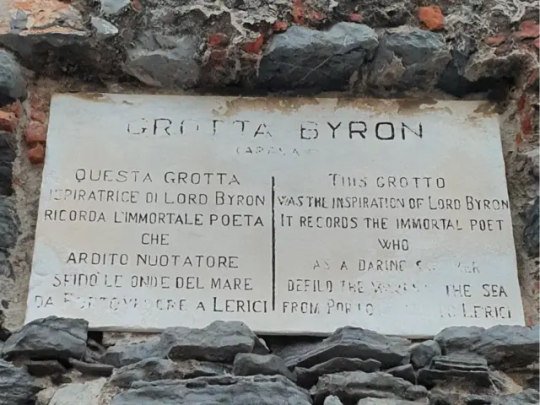
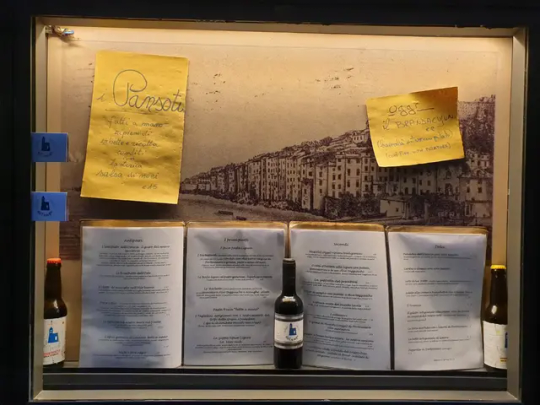

This place 44°3'19"N, 9°50'15"W has become like a super fast charger for my family. It's more than that reliable cocktail of sun & sea, fresh mussels & lemon, multi-coloured houses, pebble beaches, deep-fried anchovies and pesto. It's the time to stop. To sleep. To swim in the sea. To discuss the future. My father paints, my mother reads. We cook, we laugh, we eat out on our terrace on Via Olivo; sometimes we eat out in town. We heal.




This notebook has been coming here since 2016, filled with local illustrations, our gentle exploration of this part of the world, our routines & rituals, what we eat, what we read, what we do, how we feel. It only has a few blank pages left, so this year is its last year here.
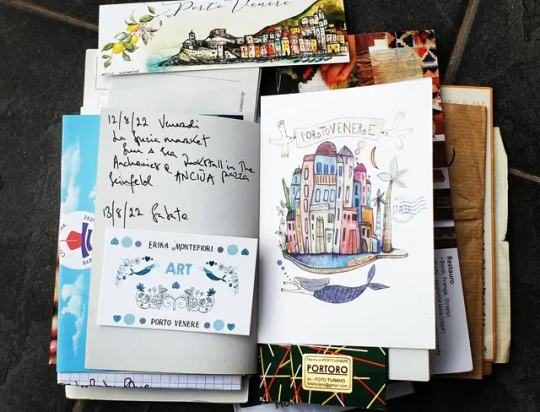


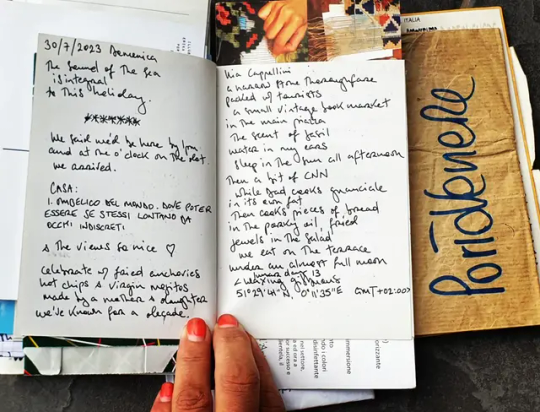
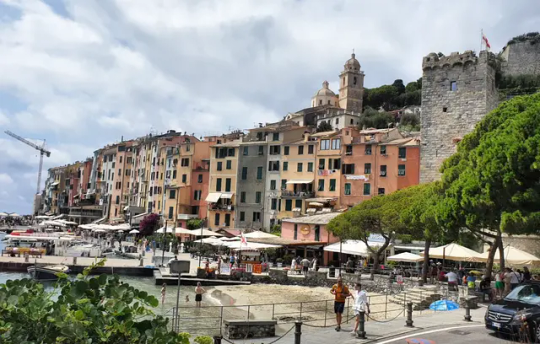
The ancient Portus Veneris is believed to date back to at least the middle of the 1st century BC. It has been said that the name refers to a temple to the goddess Venus which was sited on the promontory where the church of San Pietro now stands.
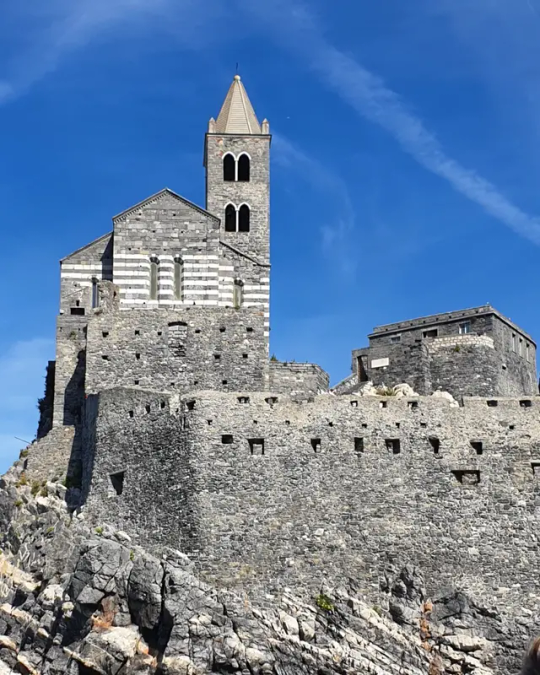
In Roman times the city was essentially a fishing community.

Via Cappellini, a narrow multi-coloured thoroughfare sometimes packed with the Cinque Terre tourists, sometimes not.
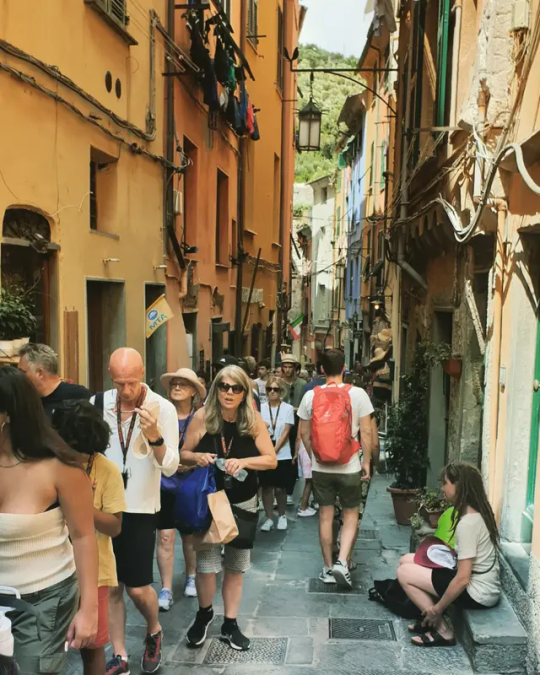
An antique vintage book market in the main square, the scent of basil, water in my ears, sleeping in the sun all afternoon then a bit of CNN news while my father cooks guanciale, adding chunks of bread which cook in the porky oil, fried jewels in the salad we eat on the terrace under an almost full Harvest moon. Waxing (very) gibbous.

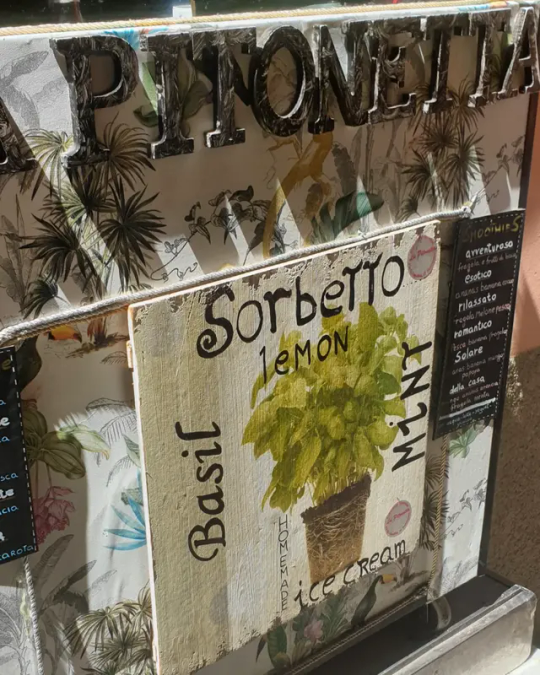

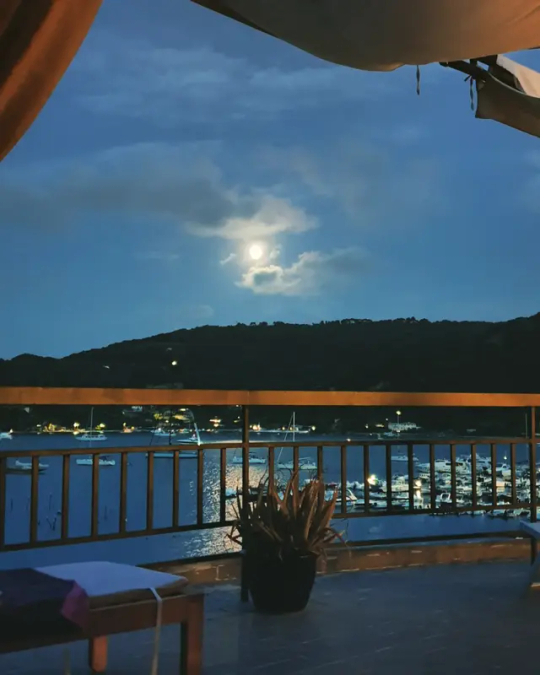
The Monday morning market in Portovenere - buying peaches & green beans, a pair of flip flops & a roast chicken from rude Riccardo.

The pebble beach in front of the American bar.
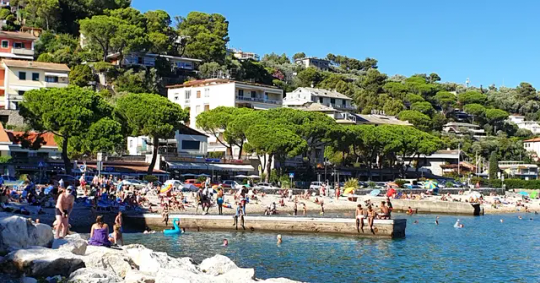


The rocks, and their mermaids.


Biting into a deep-fried anchovy in Via Cappelini. It's hot and steamy, my lips are salty, the air smells faintly of shit & lemons, sweet & sharp. We are in Portovenere and I'm so happy. This basil mojito is heaven.


There is lots to do in Portovenere. Look it up in an Eyewitness Guide. I have done everything there is "to do" in Portovenere and I really don't go to Portovenere to do stuff. I go for my August Super Fast Charge which gets me to Boxing day when I fly to Venice for a fortnight with my family for our other Super Fast Charge of the year.
Essential Summer Super Fast Charge ingredients: sun, sea, salt, basil, anchovies, lemons, books, a camera & notebook, family love.
#portovenere#summer holiday#notesonasummer#liguria#italy#notebook#travel writing#and the views so nice#anchovies#il mare#sea#sun#salt#basil#books#beach#alessiaphotography
3 notes
·
View notes
Text
The Brutalism Post, Part One: Introduction
This is part one of a five-part post about Brutalism.
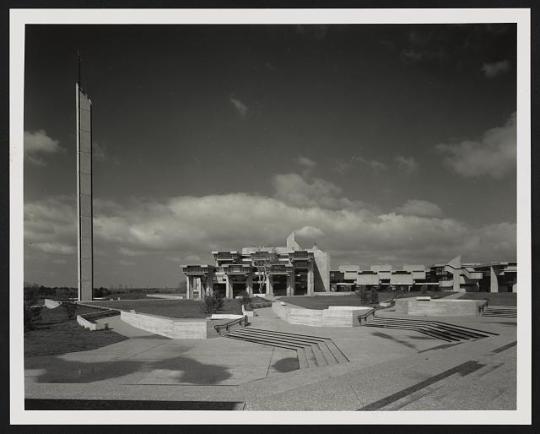
University of Massachusetts at Dartmouth campus by Paul Rudolph. Photo via Library of Congress
No style of architecture so passionately divides even the most good-natured and level-headed people as Brutalism. The discourse surrounding Brutalism being “good” or “bad” is fierce and polemical. The “for” crowd lobbies on both aesthetic grounds – posting pictures of incredible and obscure structures and saying “I mean LOOK at this” – as well as political ones, citing in particular, how Brutalism was used to house thousands of people during the postwar period.
On the other hand, the “against” crowd brings up the failed urbanism of Le Corbusier that gave us the freeways and slum clearance that split and displaced entire swaths of city fabric, proclaiming that only architects or architecture enthusiasts like Brutalism, and that this is a testament to how out of touch they are with everyday people. “If you had to live or work in these buildings,” they say, “you’d feel differently.”

Unité d'Habitation by Le Corbusier. Photo by Thomas Nemeskeri, via Flickr (CC BY-NC-ND 2.0)
I’ve been a spectator to this debate since I first lurked in the Skyscraper City forums as a high school freshman, ten years ago, when Brutalism itself sparked the interest in architecture that brings me here today. I have, as they say, heard both sides, and when asked to pick one, my response is unsatisfying. Though my personal aesthetic tastes fall on the side of “Brutalism is good,” I think the actual answer is it’s deeply, deeply complicated.
Still, what is it about Brutalism that makes it so divisive? Why does a short-lived substyle of modern architecture elicit such vehement passion in so many people? What does it even mean for a style of architecture to be “good” or “bad”? You can see why I’m drawn to finally sitting down and penning this series, which has been simmering at the back of my mind since I started McMansion Hell three years ago. (By the way, Happy Birthday to this blog!!!)
Brutalism has a special way of inspiring us to ask big and difficult questions about architecture. “Is Brutalism good?” is really a question of “is any kind of architecture good?” - is architecture itself good? And what do we mean by good? Are we talking about mere aesthetic merits? Or is it more whether or not a given work of architecture satisfies the purpose for which it was built? Can architecture be morally good? Is there a right or wrong way to make, or interpret, a building?
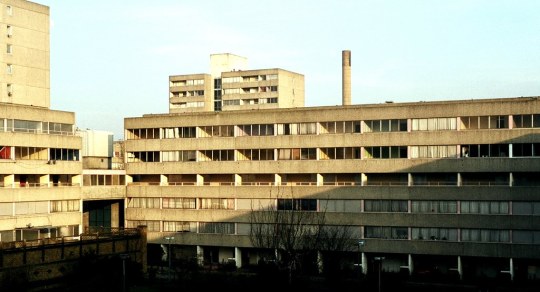
Ferrier Estate, a now-demolished social housing complex in South London. Photo by Tim Slessor via Flickr (CC BY-NC 2.0)
I have bad news for you: the answers to all of these questions are complicated, nuanced, and unsatisfying. In today’s polemical and deeply divided world of woke and cancelled, nuance has gotten a bad rap, having been frequently misused by those acting in bad faith to create blurred lines in situations where answers to questions of morality are, in reality, crystal clear. This is not my intention here.
For centuries, the philosophical discipline of aesthetics has tried in vain to articulate some kind of clearly defined standard by which we can delineate whether or not a work of art is good, bad, moral or amoral. Architecture makes this even more complicated because unlike literature, painting, music, or art, we have to live, work, and exist in architecture. Not only does the question of whether or not we can separate the art from the artist exist in architecture, so to do questions of whether or not we can separate the building from the politics, from the culture, from the time period, from the urbanism, from the socioeconomic system, from the entire contents of everyday life in which it exists.

Orange County Government Center, Perspective Drawing, by Paul Rudolph. Photo via the Library of Congress.
Existential questions aside, there are other reasons to write about Brutalism. First, while we’ve been hemming and hawing about it online, we’ve lost priceless examples of the style to either demolition or cannibalistic renovation, including Paul Rudolph’s elegant Orange County Government Center, Bertrand Goldberg’s dynamic Prentice Women’s Hospital in Chicago, and the iconic Trinity Square, Gateshead complex, famous for the role it played in the movie Get Carter. My hope is that by bringing up the nuances of Brutalism before a broad and diverse audience, other buildings on the chopping block might be spared.
On an even broader note, I think Brutalism is worth writing about simply because a lot of people are rightly confused as to what it even is. The common practice of identifying Brutalism by the presence of a material - reinforced concrete - too broadly defines a style that belongs to a specific era and architectural praxis. There are so many buildings and styles called Brutalist that are not Brutalist that I’ve devoted the first two installments of this series to the subject “What Brutalism Is Not,” followed, of course, by “What is Brutalism?” The goal is that these two essays will be educational and interesting (with the added bonus of providing the reader with an arsenal of information that will make them as insufferable at dinner parties as I am.)
The third part in this series is devoted to the people of Brutalism - the architects, politicians, planners, writers, and philosophers, who signed their names to an architectural movement that spanned the globe. Finally, the last installment gathers all this information together and answers the question we’ve all been waiting for: is Brutalism good?
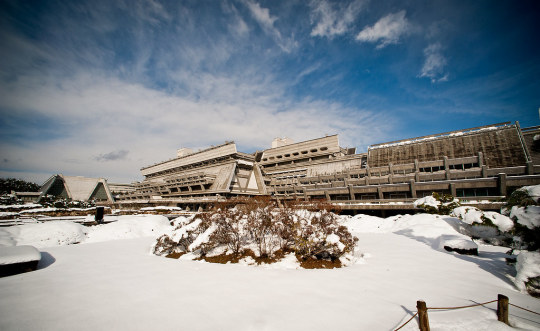
The Kyoto International Conference Center, designed by Sachio Otani. Photo by Chris Guy, via Flickr. (CC BY-NC-ND 2.0)
This is a series on Brutalism, but Brutalism itself demands a level of inquiry that goes beyond defining a style. Really, this is a series about architecture, and its relationship to the world in which it exists. Architects, as workers, artists, and ideologues, may dream up a building on paper and, with the help of laborers, erect it in the material world, but this is only the first part of the story. The rest is written by us, the people who interact with architecture as shelter; as monetary, cultural, and political capital; as labor; as an art; and, most broadly, as that which makes up the backdrop of our beautiful, complicated human lives.
---
If you like this post, and want to see more like it, consider supporting me on Patreon!
There is a whole new slate of Patreon rewards, including Good House of the Week, Crowdcast streaming, and bonus essays!
Not into recurring donations or bonus content? Consider the tip jar! Or,Check out the McMansion Hell Store ! 100% of the proceeds from the McMansion Hell store go to charity!
Copyright Disclaimer: All photographs are used in this post under fair use for the purposes of education, satire, and parody, consistent with 17 USC §107. Manipulated photos are considered derivative work and are Copyright © 2019 McMansion Hell. Please email [email protected] before using these images on another site. (am v chill about this)
#architecture#design#brutalism#brutalist architecture#architecture history#architecture theory#aesthetics#modernism
2K notes
·
View notes
Text
Bristolgames123 Nr2003 Designs

(Redirected from Bristol M.R.1 Metal Biplane)
Bristolgames123 Nr2003 Designs Custom
Bristolgames123 Nr2003 Designs Images
Bristolgames123 Nr2003 Designs Pictures
Bristolgames123 Nr2003 Designs Ideas
Original NR2003 Fictional Cars. UTICA HOME TRACK SERIES Season Sets 2014. DASCAR Regional Pro Cup 2014 #20 XSAN Chevrolet SS DOWNLOAD by Brenden.
Sailboat and sailing yacht searchable database with more than 8,000 sailboats from around the world including sailboat photos and drawings. About the BRISTOL 32 sailboat.
Initial graphics in NR2003 is terrible, but it is simple to transform it to brilliant graphics by updating some values in the files renddxg.ini and core.ini. I use the following values with my 64-bit Win7, 1024 MB Video RAM, 1920x1080 screen resolution: in file renddxg.ini: TextureSetSize=512000000 in file core.ini: CacheSize=14194304.
M.R.1RoleExperimental metal reconnaissanceNational originUnited KingdomManufacturerThe British & Colonial Aeroplane Co. LtdDesignerFrank BarnwellFirst flight1917Number built2
SIGN UP FOR NEWS AND OFFERS. WE ACCEPT: Visa, Mastercard and AMEX.


The Bristol M.R.1 was an experimental biplane with an aluminiummonocoquefuselage and metal wings, produced by Bristol during the First World War. Two were built to government order.
Development(edit)
Soon into the development of powered flight, some manufacturers were beginning to consider the use of metal in airframes to replace wood. Metal structures, even fabric-covered metal frames, offered greater robustness for handling and transportation as well as better resistance to tropical climates, and some designers could see the possibilities of metal skinning, stressed or not, for aerodynamically-clean cantilever wings and advanced monocoque fuselages. There was a realisation too, that mild steel, familiar from bicycle manufacture but with a low strength-to-weight ratio, was not going to be the material of choice once the problems of joining aluminium alloy members together and preventing their corrosion had been solved. Vickers in the UK were one of the first to make steel-framed and sparred aircraft that flew, with their series of R.E.P-type monoplanes no.s 1-8 produced between 1911 and 1913.(1) In Germany, Junkers produced the first true all-metal (for years, aircraft with fabric-clad metal frames were described as all-metal, but the Junkers was steel-skinned as well) aircraft,(2) the Junkers J.1, flown in 1915. Bristol's first draft designs for metal aircraft date from 1914, but it was not until the increase of aircraft production during the First World War began to put pressure on the supply of high-grade timber that there was official interest. During 1916 Bristol's designer, Frank Barnwell submitted a design(3) for a metal two-seat reconnaissance aircraft, the M.R.1 (M.R. for Metal Reconnaissance) and gained a contract for two evaluation aircraft.
The fuselage construction was quite novel. Barnwell borrowed from marine experience by using duralumin sheet, varnished to prevent corrosion and used these to make the fuselage in four sections. The two forward sections were semi-monocoque (i.e. open channels) with braced longitudinal upper members which, bolted together, held the engine, a water-cooled inline upright 140 hp (100 kW) Hispano-Suiza) and the pilot's cockpit. Aft, two more sections, both true monocoques, held the observer and carried the tail unit. The two cockpits were close together, with the pilot under the wing at mid-chord and the observer under a trailing edge cutout; Barnwell proposed that the short observer's fuselage section should be removable to turn the M.R.1 into a single-seater, though this configuration was not realised. The monocoque sections were very early examples of double-skinned construction, with a smooth outer skin riveted to a longitudinally-corrugated inner skin. The detailed design was by W.T.Read. The complete fuselage was of round-cornered rectangular cross-section and quite slender, mounted between the wings. The M.R.1 was a two-bay biplane without stagger or sweep, with ailerons on both planes. Aluminium wing spars proved difficult to make sufficiently rigid and Bristol outsourced their manufacture to The Steel Wing Company at Gloucester, who had built experimental steel wings for other aircraft.(3)
With the fuselage of the first M.R.1 completed before the wings, Bristol decided to make a set of conventional wooden wings, with ailerons only on the upper planes, for flight trials in mid-1917. These went well and the aircraft was handed over to the Air Board in October 1917. The second M.R.1 did not fly until late in 1918 when the metal wings were at last ready, powered by a 180 hp (130 kW) Wolseley Viper engine. It was damaged beyond repair at the end of its delivery flight to the Royal Aircraft Establishment in April 1919. The first M.R.1 was fitted with metal wings by 1918 and continued to provide useful information on metal airframe construction. In 1923, Bristol's rationalisation of type numbers labelled the M.R.1 the Type 13.(3)

Specifications(edit)

Data fromBarnes 1964, p. 129 Unfortunately Barnes did not state which engine the following specifications apply to, nor if the metal or wooden wings were used.
General characteristics
Bristolgames123 Nr2003 Designs Custom
Crew: two
Length: 27 ft 0 in (12.85 m)
Wingspan: 42 ft 2 in (8.23 m)
Height: 10 ft 3 in (3.12 m)
Wing area: 458 sq ft (42.6 m2)
Empty weight: 1,700 lb (770 kg)
Gross weight: 2,810 lb (1,275 kg)
Performance
Maximum speed: 110 mph (177 km/h, 96 kn)
Endurance: 5 hours
References(edit)
Bristolgames123 Nr2003 Designs Images

Wikimedia Commons has media related to Bristol M.R.1.
Notes
^Andrews & Morgan 1988, pp. 34–42
^Turner & Nowarra 1971, p. 11
^ abcBarnes 1964, pp. 126–9
Bristolgames123 Nr2003 Designs Pictures
Bibliography
Bristolgames123 Nr2003 Designs Ideas
Andrews, C.F.; Morgan, E.B. (1988). Vickers Aircraft since 1908. London: Putnam Publishing. ISBN0-370-00015-3.
Turner, P. StJ.; Nowarra, Heinz (1971). Junkers: an aircraft album no.3. London: Arco Publishing. ISBN0-668-02506-9.
Barnes, C. H. (1964). Bristol Aircraft since 1910. New York: Putnam Publishing. ISBN0-85177-815-1.
Retrieved from 'https://en.wikipedia.org/w/index.php?title=Bristol_M.R.1&oldid=994408348'
Award-Winning Design
WINNER Kitchen Design Contest
2015-2016
Luxe
interiors / architecture / design
2018
Innovation and Inspiration
A New Flow
2016 Best Kitchen & Bath
Before and After Kitchen
A Spa-Worthy Bath at Home
Northwest Idea House Unvelied
Back to Basics
Made in Medina
2012
2016 BEST KITCHEN & BATH
BEST BEFORE & AFTER KITCHEN
2016
Link to project
2015 Best Kitchen & Bath
Builder/Remodeler Honorary Award
2015 Fall
Award- winning DESIGNS
23 AWARD WINNING KITCHENS AND BATH
2014
Trends: Bathroom
'Sense of Sanctuary'
Link to project
Trends: Bathroom
Symmetry with a Difference
2012
Link to project
425
'2009 Best of 425'
Best Kitchen & Bath Design
The Living Kitchen
Sub Zero/Wolf Design Competition
Kitchen Solutions
Kitchen and Bath
'The Best of the Best'
Dream Baths
'Screen Scene'
May 2007
Better Homes & Gardens Remodeling
'Screen Presence'
February 2006
425
'Divine Design'
Winter 2006/07
Better Homes & Gardens Kitchen & Bath Ideas
“Function with Feeling”
January/February 2004
Link to project
Woman’s Day Kitchens & Baths
“Stowaway!”
Summer 2004
See Thru Houses Inspirational Homes & Features in Glass
By Catherine Slessor
2001
Home Magazine
“Practical Ideas”
October 2001
Bars, Pubs, Café Hot Designs for Cool Spaces
By Julie D. Taylor
2000
Portrait of Puget Sound
“At Home with the Pros”
2000-01 Volume 4
Seattle Homes & Lifestyles
“A Rambler Transformed”
March/April 2000
Interior Design
“Pacific Overtures”
March 1999
Tile & Stone
By Ann Sacks
1998

1 note
·
View note
Text
This week architects paid tribute to high-tech pioneer Richard Rogers
This week on Dezeen, we covered the news that Pritzker Architecture Prize-winning architect Richard Rogers passed away aged 88.
Rogers, who was one of the world's best-known architects, passed away in his home on 18 December. Tributes were paid to the "superstar" architect by creatives including Peter Barber, Charles Holland and Julia Barfield.
In his tribute, fellow Pritzker Architecture Prize-winner Norman Foster, who Rogers co-founded his first studio with, described him as his "oldest and closest friend".
Richard Rogers' top 10 architecture projects
Following Rogers' death we took a look at 10 of his most influential projects including the Centre Pompidou (pictured), Lloyd's building and the Millennium Dome.
In an opinion piece dicussing his legacy, critic Catherine Slessor said that "Rogers' star burned especially furiously" and that "a point of light had disappeared from a constellation of architects that shaped the last 40 years".
Valley by MVRDV photographed near completion in Amsterdam
In other architecture news, Dutch studio MVRDV revealed images of its Valley high-rise scheme that is nearing completion in Amsterdam's financial district.
The development, which is set to complete next year, is composed of three conjoined buildings linked podium to recreate the shape of a valley.
Zaha Hadid Architects creates multi-level city park in Cyprus' capital
In Cyprus, UK studio Zaha Hadid Architects unveiled a public park that runs alongside the historic Venetian walls of Nicosia.
Named Eleftheria Square, the multi-level public space was built within a section of the dry moat that surrounds the oldest part of the city.
McDonald's opens "UK's first net-zero restaurant"
This week also saw a pair of buildings in the UK claiming to be net-zero firsts.
Fast-food chain McDonald's opened "the UK's first net-zero restaurant" in Shropshire, while in London Room2 opened the "world's first whole-life net-zero hotel" in Chiswick.
Dezeen's top 10 house extensions of 2021
We countinued our review of the year this week by looking at the house extensions that turned heads in 2021.
We also rounded up the 10 non-fossil-fueled vehicles, including a coupe designed by Virgil Abloh and an electric car by Heatherwick Studio, that made an impact this year.
Carlo Ratti and Italo Rota design Italian home around 10-metre-tall tree
Popular projects this week included a house designed by Carlo Ratti and Italo Rota around a ten-metre-tall tree, a monolithic church in an Italian hill top town and a house in Japan that includes an Aztec-informed pyramid.
Our lookbook this week focused on eclectic living rooms with statement rugs.
This week on Dezeen is our regular roundup of the week's top news stories. Subscribe to our newsletters to be sure you don't miss anything.
The post This week architects paid tribute to high-tech pioneer Richard Rogers appeared first on Dezeen.
0 notes
Text
The Story of how Mary Slessor Stopped the killing of Twins but sadly died of Fever.
Killing new-born twins was common practice in the 19th century among the Ibibio people of Nigeria, but one Scotswoman went to great lengths to put an end to this.
Aberdeen-born Mary Slessor was one of the few missionaries in Africa who learnt the local language, adapted to the native customs and environment and gained the trust of the locals in order to make a truly positive impact.
Her father, a shoe-maker from Buchan, became incapacitated by alcoholism and Mary more or less became the breadwinner for the family. From the age of 11, she worked as a ‘half-timer’ mill girl in the Baxter Brothers and Co Ltd, spending half the day at a school provided by the mill owners and the other half working for the company
By the age of 14, she had become a skilled jute worker, but Mary had bigger plans for her future.
Inspired by her mother’s issues of the Missionary Record, Mary began to teach voluntarily at the new Dundee mission. When David Livingstone died in 1873, resulting in a nationwide call for more missionaries, Mary decided to follow in his footsteps. She set sail in the SS Ethiopia on 5 August 1876, arriving in West Africa just over a month later, aged 28. Mary was first assigned to Calabar in southern Nigeria where her duties included teaching children and working in the dispensary.
Along with learning the local language, Efik, she adapted to eating the local food to save money so that she could send a large chunk of her wages back home to support her sister and mother.
While her broad Dundonian accent was hard to disguise, Mary tried to blend in by cutting her bright red hair short and discarding her Victorian clothes.
She became known for her interest in women and children’s rights and wellbeing, which were often at risk in Calabar. When twins were born, it was thought that one of them was the child of the devil and since it wasn’t known which one, both would be left for dead in a bush and the mother banished from the community – often a death sentence itself.
Mary soon took it upon herself to rescue and protect these vulnerable women and children and made it her priority to change cultural beliefs about twins. Although it was discouraged by the mission society to adopt any of the abandoned children, Mary was one of the few who ignored the rules.
She sent out twins’ missioners to find and care for abandoned twins at the mission house, and adopted every child she found. Once, she took in a baby girl as her own daughter, calling her Janie and eventually taking her back to Scotland.
Over her lifetime, Mary saved hundreds of twins from the bush. She also helped heal the sick and put an end to the practise of making suspects drink poison to determine whether they were guilty. As a missionary, she travelled to other tribes, spreading the word of Jesus Christ.
In 1888 she travelled north to Okoyong and lived a simple life there for 15 years among the Okoyong and Efik people and became known as the ‘white queen of Okoyong’.
She continued her focus on settling disputes, encouraging trade, establishing social change, introducing western education and evangelism. In 1892 she became vice-consul in Okoyong, presiding over the native court and in 1905, she was named vice-president of Ikot Obong native court before being awarded the order of St. John of Jerusalem in 1913.
Because she always placed the needs of others before her own, Mary was often challenged by ill health and battled bouts of malaria and other tropical diseases. These sometimes got so severe she had to go home to Dundee to recover but always made sure to return to her mission. She passed away in 1915 at the age of 66 in Calabar. Mary was given a state funeral and buried in Duke Town in Nigeria with a large granite cross from Scotland across her grave.
More than 100 years since her death, Mary’s legacy lives on both in Africa and closer to home. Several memorials testify to the value placed on her work, with a road, a roundabout, a church and various statues commemorating her in Calabar.
In Scotland, a bust of Mary was erected in the Hall of Heroes of the national Wallace Monument in Stirling and in 2015, a memorial was unveiled in Dundee marking the 100th anniversary of her death.
Mary also appeared in 1997 on Clydesdale Bank’s £10 notes, earning her a place in history as the first female to be commemorated on a Scottish bank note – a fitting honour for such a remarkable individual.
The Mary Slessor Foundation was established in 2002 with the aim of continuing the social, economic and medical work of Mary. The foundation has set up a clinic, a skills centre and an agricultural processing unit and trains young Nigerians in practical skills to help them prosper.
Shared from #Esanpeopleblog

1 note
·
View note
Note
Is architecture basically just finding inspiration in something and constructing a building based on that inspiration?
Nothing is further from the truth.
Architecture is…
1. “Architecture is definitely a political act.” - Peter Eisenman in Haaretz
2. “Architecture is unnecessarily difficult. It’s very tough.” - Zaha Hadid in The Guardian
3. “Architecture is by definition a very collaborative process.” - Joshua Prince-Ramus in Fast Company
4. “Architecture is a way of seeing, thinking and questioning our world and our place in it.” - Thom Maynein his Prtizker Prize Acceptance Speech
5. “Architecture is the art and science of making sure that our cities and buildings actually fit with the way we want to live our lives: the process of manifesting our society into our physical world. - Bjarke Ingels in AD Interviews
6. “Architecture is merciless: it is what it is, it works or doesn’t, and you can clearly see the difference.” - Jacques Herzog in a lecture at Columbia University
7. “Architecture is always related to power and related to large interests, whether financial or political.“ - Bernard Tschumi in The New York Times
8. "Architecture is a good example of the complex dynamic of giving.” - Jeffrey Inaba in World of Giving
9. “Architecture is too complex for just one person to do it, and I love collaboration.” - Richard Rogers in The Guardian
10. “Architecture is the most powerful deed that a man can imagine.” - Ben van Berkel and Caroline Bosin Volume
11. “Architecture is an act of optimism.” - Nicolai Ouroussoff in The LA Times

12. “Architecture is an artificial fact.” - Mario Botta in Perspecta
13. “Architecture is full of romantics who think that even relatively small changes to the built environment create the aspiration for a better society.” - Mark Wigley in Surface Magazine
14. “Architecture is for us, the public, and it is going to get scuffed.” - Alexandra Lange in Design Observer
15. “Architecture is the work of nations…” John Ruskin in Stones of Venice
16. “Architecture is always dream and function, expression of a utopia and instrument of a convenience.” - Roland Barthes in “Semiology and Urbanism”
17. “Architecture is an expression of values – the way we build is a reflection of the way we live.” - Norman Foster in The European
18. “Architecture is the real battleground of the spirit.” - Ludwig Mies van der Rohe in “ID Merger Speech”
19. “Architecture is not a question of the purely theoretical if you’re interested in building buildings. It’s the art of what is possible.” - Paul Rudolph in Chicago Architects Oral History Project
20. “Architecture is geometry.” - Álvaro Siza in Imaginar a Evidência (Imagining Evidence)
21. “Architecture is about improving conditions: environmental, social and sometimes also political.” - Arjen Oosterman in Volume
22. “Architecture is not just one thing. It is not just an art. … It has to deal with the real situation; it has to do something good for the society.” - Xiaodu Liu in “What Can Architecture Do? An Interview with Xiaodu Liu” on ArchDaily
23. “Architecture is much more than the building of an object on a site: it is a reinvention of the site itself.” - Sean Lally in The Air From Other Planets
24. “Architecture is a language: new designs should abide by grammatical rules to avoid dissonance with existing structures.” - Prince Charles in The Architectural Review
25. “Architecture is an untapped source of magnificent stories waiting to be imagined, visualized, and built.” - Matthew Hoffman in “Blank Space Launches Architecture Storytelling Competition”
26. “Architecture is about serving others through the design of the built environment.” - Kevin J Singh in “21 Rules for A Successful Life in Architecture”
27. “Architecture is a very complex effort everywhere. It’s very rare that all the forces that need to coincide to actually make a project proceed are happening at the same time.” - Rem Koolhaas in Co.Design
28. “Architecture is intended to transcend the simple need for shelter and security by becoming an expression of artistry.” - Jay A. Pritzker in his 1985 Pritzker Ceremony Speech
29. “Architecture is the only art that you can’t help but feel. You can avoid paintings, you can avoid music, and you can even avoid history. But good luck getting away from architecture.” - Philippe Daverio in Humans of New York
30. “Architecture is the petrification of a cultural moment.” - Jean Nouvel in Newsweek
31. “Architecture is characterised by endurance and longevity: a long education, long training, long hours and long lives.” - Catherine Slessor in The Architectural Review
32. “Architecture is a muddle of irreconcilable things.” - Juhani Pallasmaa in The Architectural Review
33. “Architecture is, in many ways, a very specific type of science fiction; it is its own genre of speculative thought,” - Geoff Manaugh in Architect
34. “Architecture is largely irrelevant to the great mass of the world’s population because architects have chosen to be.” - Bruce Mau in Architect
35. “Architecture is becoming less about a single walled-off phallus on the horizon, and more about parks and public spaces which engage with the city.” - Alissa Walker in Gizmodo
36. “Architecture is most often a victory over the process of creating architecture.” - Sam Jacob in Log
37. “Architecture is capable of mounting a profound critique of the status quo.” - Reinhold Martin in Places
38. “Architecture is such a conspicuous immensely physical object in space its presence is bound to influence everyone.” - Gautam Bhatia in India International Centre Quarterly
39. "Architecture is not just about building. It’s a means of improving people’s quality of life.” - Diébédo Francis Kéré in Washington Post
40. “Architecture is a physical experience — it needs to be seen and touched to be wholly understood.” - Nicolai Ouroussoff in Los Angeles Times
41. “Architecture is really difficult. I realized that only very recently. It’s like music. You can enjoy it but — to know it — it’s a different story.” - Diana Agrest in nprEd
42. “Architecture is capable of absorbing anything, and hence tends to dissolve into everything.” - Ole Bouman in Volume
43. “Architecture is not just a matter of technology and aesthetics but the frame for a way of life – and, with luck, an intelligent way of life.” - Bernard Rudofsky
44. “Architecture is a discipline where you can have multivalent interests. You could be a philosopher, a geographer, a scientist, an artist, an engineer; you can be poetic about it.” - Toshiko Mori in Metropolis

45. “Architecture is supposed to be about a higher purpose.” - Stanley Tigerman in Newsweek
46. “Architecture is the most public of the arts, and the public are severe critics.” - Eric Parry in The Guardian
47. “Architecture is a formmaker, problem‐solver and environment‐creator, and the international exposition is its laboratory.” - Ada Louise Huxtable in New York Times
48. “Architecture is supposed to complete nature. Great architecture makes nature more beautiful—it gives it power.”- Claudio Silvestrin in Elle Decor
49. “Architecture is a small piece of this human equation, but for those of us who practice it, we believe in its potential to make a difference, to enlighten and to enrich the human experience, to penetrate the barriers of misunderstanding and provide a beautiful context for life’s drama.” - Frank Gehry in his 1989 Pritzker Prize Ceremony Speech
50. “Architecture is not a private affair; even a house must serve a whole family and its friends, and most buildings are used by everybody, people of all walks of life. If a building is to meet the needs of all the people, the architect must look for some common ground of understanding and experience.” - John Portman in “The Architect as Developer”
51. “Architecture is a social art. And as a social art, it is our social responsibility to make sure that we are delivering architecture that meets not only functional and creature comforts, but also spiritual comfort.” - Samuel Mockbee
52. “Architecture is too important to be left to men alone.” - Sarah Wigglesworth in Parlour
53. “Architecture is not a purely private transaction between architects and clients. It affects everyone, so it ought to be understandable to everyone. - Blair Kamin
54. "Architecture is vital and enduring because it contains us; it describes space, space we move through, exit in and use.” - Richard Meier in his 1984 Pritzker Prize Ceremony Speech
55. “Architecture is more about ideas than materials.” - Qingyun Ma in Los Angeles Times
56. “Architecture is not just for big star projects like museums. It’s for the slums around them, too.” - Juan Ramon Adsuara in npr
57. “Architecture is bashful about reality.” - Wouter Vanstiphout in Archis
58. “Architecture is just background. The beauty of architecture is that it brings people together and can create public constructs.” - Ben Van Berkel in AD Interviews
59. “Architecture is about hope, about change—it makes life more exciting.” - Lars Lerup in Architect
60. “Architecture is blessed and cursed with more dimensions than its greats know what to do with: the three of sensible space, the celebrated fourth of travel through it; and others, ineffable, beyond—the fifth of utility, say, the seventh of happy accident, the ominous eleventh.” - Philip Nobel in Metropolis
61. “Architecture is a mystery that must be preserved.” - Jean Nouvel in Huffington Post
62. “Architecture is only as great as the aspirations of its society.” - Lisa Rochon in Globe and Mail
63.“Architecture is like the picture of Dorian Gray: It can look beautiful in public, while somewhere out of sight its true soul withers and rots.” - Lance Hosey in Architect
64. “Architecture is about reason-right?” - Alfred Caldwell in Chicago Tribune
65. “Architecture is a profession of optimism.” - Johanna Hurme in spacing
66. “Architecture is about the manipulation of light: both artificial light and day lighting.”- Tom Kundigin Architectural Record
67. “Architecture is expected to carry too much weight in many cases.” - Patricia Patkau in Globe and Mail
68. “Architecture is not a goal. Architecture is for life and pleasure and work and for people. The picture frame, not the picture.” - William Wurster
69. “Architecture is the most obvious flower of a society’s culture.” - Alan Balfour in Art Papers
70. “Architecture is more than making a statement from the street. It’s making an environment for living.” - Dion Neutra in Los Angeles Times
71. “Architecture is a translation process.” - Fernando Romero in Metropolis
72. "Architecture is quite a narrow, obsessive business.” - Nicholas Grimshaw in The Guardian
73. “Architecture is perplexing in how inconsistent is its capacity to generate the happiness on which its claim to our attention is founded.” - Alain de Botton in The Architecture of Happiness
74. “Architecture is a kind of urban ballet.” - Aaron Betsky in New York Times
75. “Architecture is a history of style written by the victors.” - Herbert Muschamp in New York Times
76. “Architecture is driven by belief in the nature of the real and the physical: the specific qualities of one thing - its material, form, arrangement, substance, detail - over another.” - Kester Rattenbury in This is Not Architecture: Media Constructions
77. “Architecture is not always synonymous with building.” - Francisco “Patxi” Mangado
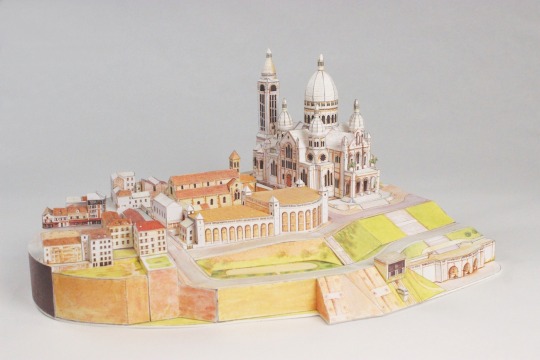
78. “Architecture is complicated and like other complicated things it is prone to entropy from the outset.” - Guy Horton in Metropolis
79. “Architecture is where imagination meets life.” - Kazuyo Sejima & Ryue Nishizawa in their 2010 Pritzker Prize Ceremony Speech
80. “Architecture is an incredible ego trip. You get things done, you build them, you look at them. That’s why I enjoy life and don’t have an ulcer. - Stanley Tigerman in the Chicago Tribune
81. "Architecture is a strange field where we’re constantly asked to demonstrate over and over why design matters, to everyone, all the time. It’s exhausting.” - Amale Andraos in Metropolis
82. “Architecture is about the lack of stability and how to address it. Architecture is about the void and how to cross it. Architecture is about inhospitability and how to live within it.” - Geoff Manaugh in The Guardian
83. “Architecture is both an art and a practical pursuit, and the profession has always been divided between those who emphasize the art, that is pure design, and those who give priority to the practical.” - Paul Goldberger in New York Times
84. Architecture is one of the reflections of the permanence of a civilization. - Charlie Rose
85. Architecture is not a profession for the faint-hearted, the weak-willed, or the short-lived. - Martin Fillerin The New York Review of Books
86. “Architecture is a very dangerous job. If a writer makes a bad book, eh, people don’t read it. But if you make bad architecture, you impose ugliness on a place for a hundred years.” - Renzo Piano in Time
87. “Architecture is the pathology of the contemporary era.” - Forensic Architecture
88. “Architecture is a discipline directly engaged with shaping enclosure, of erecting and toppling barriers or—more explicitly—of extending and limiting ‘freedoms’.” - E. Sean Bailey & Erandi de Silva in “BI’s First Print Edition Released - FREE: Architecture on the Loose”
89. “Architecture is interesting, but by itself it means nothing.” - Massimiliano Fuksas in New York Times
90. “Architecture is an art, yet we rarely concentrate our attention on buildings as we do on plays, books, and paintings.” - Witold Rybczynski in Metropolis
91. “Architecture is aligned with and implicated in the systems of surveillance and control.” - Eric Howelerin Volume
92. “Architecture is 90 per cent business and 10 per cent art.” - Albert Kahn
93. “Architecture is probably the subject of more theorizing, navel-gazing and introspective agonizing than any of the other arts.” - Paul Gapp in the Chicago Tribune
94. “Architecture is invention.”- Oscar Niemeyer in Newsweek
95. “Architecture is always political.” - Richard Rogers in Financial Times
96. “Architecture is a frame of mind, it’s about ideas; the profession is about how to translate those ideas into the real world.” - Christopher Janney in Architectural Record
97. “Architecture is an active participant in the interactions of people within it.” - Jonathan C. Molloyin ArchDaily
98. “Architecture is not only developing in its own realm, it is constantly assimilating achievements from other fields. - Maya Engeli in Volume
99. "Architecture is first and foremost about serving people and society. This is an architect’s responsibility: to design buildings that fulfill their practical purpose, bring people together, and connect us to the natural world while preserving precious resources.” - Steven Ehrlich in Metropolis
100. “Architecture is about building a place in the universe, not about mimicking a depleted, decrepit reality.” - Stefanos Polyzoides in The LA Times
101. “Architecture is a public commodity, and as such invites public scrutiny.” - Reed Kroloff in Architecture*
102. “Architecture is not about the creation of newness but rather about the fulfillment of needs and expectations.“ - André Tavares in Forbes
103. "Architecture is the same as advertising for communicating the brand.” - Patrizio Bertelli in The New York Times
104. “Architecture is not just about accommodating very prescriptive demands—it’s doing it in a way that stimulates the unfolding of life. - Bjarke Ingels in Co.Design
105. "Architecture is exposed to life. If its body is sensitive enough, it can assume a quality that bears witness to past life.” - Peter Zumthor in Thinking Architecture
106. “Architecture is flexible.” - Krzysztof Wodiczko in St. Louis Post - Dispatch*
107. "Architecture is a combination of science and fiction.” - Winy Maas in Domus
108. “Architecture is the art we all encounter most often, most intimately, yet precisely because it is functional and necessary to life, it’s hard to be clear about where the "art” in a building begins.“ - Jonathan Jones in The Guardian
109. "Architecture is not an inspirational business, it’s a rational procedure to do sensible and hopefully beautiful things; that’s all.” Harry Seidler in the Sydney Morning Herald

110. “Architecture is used by political leaders to seduce, to impress, and to intimidate.” - Deyan Sudjic inThe Washington Post
111. "Architecture is a paradigm for reconsidering research.” B.D. Wortham in Journal of Architectural Education*
112. "Architecture is about giving form to the places where people live. It is not more complicated than that but also not simpler than that. - Alejandro Aravena in his 2016 Pritzker Prize acceptance speech
113. "Architecture is generally a poor relative to things like film, fashion and product design. Even though it is economically more important, for some reason it is not getting the recognition.” - Tamsie Thomsonin The Architects’ Journal
114. “Architecture is a complex and articulated process but if you lose the process and only keep the form you lose the core of architectural practice.” - André Tavares in Wallpaper*
116. “Architecture is practical poetry.” - Bjarke Ingels at the New Yorker Festival
117. “Architecture is the sum of inevitable negotiations.” - Felipe Mesa in Domus
118. “Architecture is more than just buildings; these structures can inspire and motivate people to do great things.” Fisk Johnson for the 2017 Chicago Architecture Biennial
119. “Architecture is one of those disciplines that has no shortage of voices.” - Guy Horton in Metropolis
120.“Architecture is always a temporary modification of the space, of the city, of the landscape. We think that it’s permanent. But we never know.” - Jean Nouvel in The New York Times
121. “Architecture is like life: a matter of trade-offs.” - Paul Goldberger in The New York Times
Quotes via
Paper Architectural Models via
517 notes
·
View notes
Text
Operatives of the newly launched security outfit in Cross River state "Operation Akpakwu" have arrested a notorious kidn
Operatives of the newly launched security outfit in Cross River state “Operation Akpakwu” have arrested a notorious kidn

Operatives of the newly launched security outfit in Cross River state “Operation Akpakwu” have arrested a notorious kidnap kingpin identified as Etim Etim Bassey and members of his gang.
The suspect and his gang members were arrested on Tuesday, December 8 around the Anantigha axis of Calabar South following credible intelligence report.
The same day at noon, another set of daredevil…
View On WordPress
0 notes
Photo

Mary Mitchell Slessor was a Scottish Presbyterian Missionary to Nigeria. Once in Nigeria, Slessor learned Efik language, then began teaching. Stoppage of the killing of twins was her passion! She was born on December 2, 1848 at Aberdeen, United Kingdom and she died on January 13, 1915 in Nigeria. Below is Mary Slessor's House in Cross River State built in 1876. The sad reality is that twins are still being discreetly killed till tomorrow for cultural reasons in Nigeria. If you doubt my submission Google it yourself. You will be shocked! May Nigeria succeed. #twins https://www.instagram.com/p/CAnYVhxp7Ec/?igshid=1uxy2gaff6h32
0 notes
Text
Architecture is…
1. “Architecture is definitely a political act.” - Peter Eisenman in Haaretz
2. “Architecture is unnecessarily difficult. It’s very tough.” - Zaha Hadid in The Guardian
3. “Architecture is by definition a very collaborative process.” - Joshua Prince-Ramus in Fast Company
4. “Architecture is a way of seeing, thinking and questioning our world and our place in it.” - Thom Maynein his Prtizker Prize Acceptance Speech
5. “Architecture is the art and science of making sure that our cities and buildings actually fit with the way we want to live our lives: the process of manifesting our society into our physical world. - Bjarke Ingels in AD Interviews
6. “Architecture is merciless: it is what it is, it works or doesn’t, and you can clearly see the difference.” - Jacques Herzog in a lecture at Columbia University
7. “Architecture is always related to power and related to large interests, whether financial or political.“ - Bernard Tschumi in The New York Times
8. "Architecture is a good example of the complex dynamic of giving.” - Jeffrey Inaba in World of Giving
9. “Architecture is too complex for just one person to do it, and I love collaboration.” - Richard Rogers in The Guardian
10. “Architecture is the most powerful deed that a man can imagine.” - Ben van Berkel and Caroline Bosin Volume
11. “Architecture is an act of optimism.” - Nicolai Ouroussoff in The LA Times
12. “Architecture is an artificial fact.” - Mario Botta in Perspecta
13. “Architecture is full of romantics who think that even relatively small changes to the built environment create the aspiration for a better society.” - Mark Wigley in Surface Magazine
14. “Architecture is for us, the public, and it is going to get scuffed.” - Alexandra Lange in Design Observer
15. “Architecture is the work of nations…” John Ruskin in Stones of Venice
16. “Architecture is always dream and function, expression of a utopia and instrument of a convenience.” - Roland Barthes in “Semiology and Urbanism”
17. “Architecture is an expression of values – the way we build is a reflection of the way we live.” - Norman Foster in The European
18. “Architecture is the real battleground of the spirit.” - Ludwig Mies van der Rohe in “ID Merger Speech”
19. “Architecture is not a question of the purely theoretical if you’re interested in building buildings. It’s the art of what is possible.” - Paul Rudolph in Chicago Architects Oral History Project
20. “Architecture is geometry.” - Álvaro Siza in Imaginar a Evidência (Imagining Evidence)
21. “Architecture is about improving conditions: environmental, social and sometimes also political.” - Arjen Oosterman in Volume
22. “Architecture is not just one thing. It is not just an art. … It has to deal with the real situation; it has to do something good for the society.” - Xiaodu Liu in “What Can Architecture Do? An Interview with Xiaodu Liu” on ArchDaily
23. “Architecture is much more than the building of an object on a site: it is a reinvention of the site itself.” - Sean Lally in The Air From Other Planets
24. “Architecture is a language: new designs should abide by grammatical rules to avoid dissonance with existing structures.” - Prince Charles in The Architectural Review
25. “Architecture is an untapped source of magnificent stories waiting to be imagined, visualized, and built.” - Matthew Hoffman in “Blank Space Launches Architecture Storytelling Competition”
26. “Architecture is about serving others through the design of the built environment.” - Kevin J Singh in “21 Rules for A Successful Life in Architecture”
27. “Architecture is a very complex effort everywhere. It’s very rare that all the forces that need to coincide to actually make a project proceed are happening at the same time.” - Rem Koolhaas in Co.Design
28. “Architecture is intended to transcend the simple need for shelter and security by becoming an expression of artistry.” - Jay A. Pritzker in his 1985 Pritzker Ceremony Speech
29. “Architecture is the only art that you can’t help but feel. You can avoid paintings, you can avoid music, and you can even avoid history. But good luck getting away from architecture.” - Philippe Daverio in Humans of New York
30. “Architecture is the petrification of a cultural moment.” - Jean Nouvel in Newsweek
31. “Architecture is characterised by endurance and longevity: a long education, long training, long hours and long lives.” - Catherine Slessor in The Architectural Review
32. “Architecture is a muddle of irreconcilable things.” - Juhani Pallasmaa in The Architectural Review
33. “Architecture is, in many ways, a very specific type of science fiction; it is its own genre of speculative thought,” - Geoff Manaugh in Architect
34. “Architecture is largely irrelevant to the great mass of the world’s population because architects have chosen to be.” - Bruce Mau in Architect
35. “Architecture is becoming less about a single walled-off phallus on the horizon, and more about parks and public spaces which engage with the city.” - Alissa Walker in Gizmodo
36. “Architecture is most often a victory over the process of creating architecture.” - Sam Jacob in Log
37. “Architecture is capable of mounting a profound critique of the status quo.” - Reinhold Martin in Places
38. “Architecture is such a conspicuous immensely physical object in space its presence is bound to influence everyone.” - Gautam Bhatia in India International Centre Quarterly
39. "Architecture is not just about building. It’s a means of improving people’s quality of life.” - Diébédo Francis Kéré in Washington Post
40. “Architecture is a physical experience — it needs to be seen and touched to be wholly understood.” - Nicolai Ouroussoff in Los Angeles Times
41. “Architecture is really difficult. I realized that only very recently. It’s like music. You can enjoy it but — to know it — it’s a different story.” - Diana Agrest in nprEd
42. “Architecture is capable of absorbing anything, and hence tends to dissolve into everything.” - Ole Bouman in Volume
43. “Architecture is not just a matter of technology and aesthetics but the frame for a way of life – and, with luck, an intelligent way of life.” - Bernard Rudofsky
44. “Architecture is a discipline where you can have multivalent interests. You could be a philosopher, a geographer, a scientist, an artist, an engineer; you can be poetic about it.” - Toshiko Mori in Metropolis
45. “Architecture is supposed to be about a higher purpose.” - Stanley Tigerman in Newsweek
46. “Architecture is the most public of the arts, and the public are severe critics.” - Eric Parry in The Guardian
47. “Architecture is a formmaker, problem‐solver and environment‐creator, and the international exposition is its laboratory.” - Ada Louise Huxtable in New York Times
48. “Architecture is supposed to complete nature. Great architecture makes nature more beautiful—it gives it power.”- Claudio Silvestrin in Elle Decor
49. “Architecture is a small piece of this human equation, but for those of us who practice it, we believe in its potential to make a difference, to enlighten and to enrich the human experience, to penetrate the barriers of misunderstanding and provide a beautiful context for life’s drama.” - Frank Gehry in his 1989 Pritzker Prize Ceremony Speech
50. “Architecture is not a private affair; even a house must serve a whole family and its friends, and most buildings are used by everybody, people of all walks of life. If a building is to meet the needs of all the people, the architect must look for some common ground of understanding and experience.” - John Portman in “The Architect as Developer”
51. “Architecture is a social art. And as a social art, it is our social responsibility to make sure that we are delivering architecture that meets not only functional and creature comforts, but also spiritual comfort.” - Samuel Mockbee
52. “Architecture is too important to be left to men alone.” - Sarah Wigglesworth in Parlour
53. “Architecture is not a purely private transaction between architects and clients. It affects everyone, so it ought to be understandable to everyone. - Blair Kamin
54. "Architecture is vital and enduring because it contains us; it describes space, space we move through, exit in and use.” - Richard Meier in his 1984 Pritzker Prize Ceremony Speech
55. “Architecture is more about ideas than materials.” - Qingyun Ma in Los Angeles Times
56. “Architecture is not just for big star projects like museums. It’s for the slums around them, too.” - Juan Ramon Adsuara in npr
57. “Architecture is bashful about reality.” - Wouter Vanstiphout in Archis
58. “Architecture is just background. The beauty of architecture is that it brings people together and can create public constructs.” - Ben Van Berkel in AD Interviews
59. “Architecture is about hope, about change—it makes life more exciting.” - Lars Lerup in Architect
60. “Architecture is blessed and cursed with more dimensions than its greats know what to do with: the three of sensible space, the celebrated fourth of travel through it; and others, ineffable, beyond—the fifth of utility, say, the seventh of happy accident, the ominous eleventh.” - Philip Nobel in Metropolis
61. “Architecture is a mystery that must be preserved.” - Jean Nouvel in Huffington Post
62. “Architecture is only as great as the aspirations of its society.” - Lisa Rochon in Globe and Mail
63.“Architecture is like the picture of Dorian Gray: It can look beautiful in public, while somewhere out of sight its true soul withers and rots.” - Lance Hosey in Architect
64. “Architecture is about reason-right?” - Alfred Caldwell in Chicago Tribune
65. “Architecture is a profession of optimism.” - Johanna Hurme in spacing
66. “Architecture is about the manipulation of light: both artificial light and day lighting.”- Tom Kundigin Architectural Record
67. “Architecture is expected to carry too much weight in many cases.” - Patricia Patkau in Globe and Mail
68. “Architecture is not a goal. Architecture is for life and pleasure and work and for people. The picture frame, not the picture.” - William Wurster
69. “Architecture is the most obvious flower of a society’s culture.” - Alan Balfour in Art Papers
70. “Architecture is more than making a statement from the street. It’s making an environment for living.” - Dion Neutra in Los Angeles Times
71. “Architecture is a translation process.” - Fernando Romero in Metropolis
72. "Architecture is quite a narrow, obsessive business.” - Nicholas Grimshaw in The Guardian
73. “Architecture is perplexing in how inconsistent is its capacity to generate the happiness on which its claim to our attention is founded.” - Alain de Botton in The Architecture of Happiness
74. “Architecture is a kind of urban ballet.” - Aaron Betsky in New York Times
75. “Architecture is a history of style written by the victors.” - Herbert Muschamp in New York Times
76. “Architecture is driven by belief in the nature of the real and the physical: the specific qualities of one thing - its material, form, arrangement, substance, detail - over another.” - Kester Rattenbury in This is Not Architecture: Media Constructions
77. “Architecture is not always synonymous with building.” - Francisco “Patxi” Mangado
78. “Architecture is complicated and like other complicated things it is prone to entropy from the outset.” - Guy Horton in Metropolis
79. “Architecture is where imagination meets life.” - Kazuyo Sejima & Ryue Nishizawa in their 2010 Pritzker Prize Ceremony Speech
80. “Architecture is an incredible ego trip. You get things done, you build them, you look at them. That’s why I enjoy life and don’t have an ulcer. - Stanley Tigerman in the Chicago Tribune
81. "Architecture is a strange field where we’re constantly asked to demonstrate over and over why design matters, to everyone, all the time. It’s exhausting.” - Amale Andraos in Metropolis
82. “Architecture is about the lack of stability and how to address it. Architecture is about the void and how to cross it. Architecture is about inhospitability and how to live within it.” - Geoff Manaugh in The Guardian
83. “Architecture is both an art and a practical pursuit, and the profession has always been divided between those who emphasize the art, that is pure design, and those who give priority to the practical.” - Paul Goldberger in New York Times
84. Architecture is one of the reflections of the permanence of a civilization. - Charlie Rose
85. Architecture is not a profession for the faint-hearted, the weak-willed, or the short-lived. - Martin Fillerin The New York Review of Books
86. “Architecture is a very dangerous job. If a writer makes a bad book, eh, people don’t read it. But if you make bad architecture, you impose ugliness on a place for a hundred years.” - Renzo Piano in Time
87. “Architecture is the pathology of the contemporary era.” - Forensic Architecture
88. “Architecture is a discipline directly engaged with shaping enclosure, of erecting and toppling barriers or—more explicitly—of extending and limiting ‘freedoms’.” - E. Sean Bailey & Erandi de Silva in “BI’s First Print Edition Released - FREE: Architecture on the Loose”
89. “Architecture is interesting, but by itself it means nothing.” - Massimiliano Fuksas in New York Times
90. “Architecture is an art, yet we rarely concentrate our attention on buildings as we do on plays, books, and paintings.” - Witold Rybczynski in Metropolis
91. “Architecture is aligned with and implicated in the systems of surveillance and control.” - Eric Howelerin Volume
92. “Architecture is 90 per cent business and 10 per cent art.” - Albert Kahn
93. “Architecture is probably the subject of more theorizing, navel-gazing and introspective agonizing than any of the other arts.” - Paul Gapp in the Chicago Tribune
94. “Architecture is invention.”- Oscar Niemeyer in Newsweek
95. “Architecture is always political.” - Richard Rogers in Financial Times
96. “Architecture is a frame of mind, it’s about ideas; the profession is about how to translate those ideas into the real world.” - Christopher Janney in Architectural Record
97. “Architecture is an active participant in the interactions of people within it.” - Jonathan C. Molloyin ArchDaily
98. “Architecture is not only developing in its own realm, it is constantly assimilating achievements from other fields. - Maya Engeli in Volume
99. "Architecture is first and foremost about serving people and society. This is an architect’s responsibility: to design buildings that fulfill their practical purpose, bring people together, and connect us to the natural world while preserving precious resources.” - Steven Ehrlich in Metropolis
100. “Architecture is about building a place in the universe, not about mimicking a depleted, decrepit reality.” - Stefanos Polyzoides in The LA Times
101. “Architecture is a public commodity, and as such invites public scrutiny.” - Reed Kroloff in Architecture*
102. “Architecture is not about the creation of newness but rather about the fulfillment of needs and expectations.“ - André Tavares in Forbes
103. "Architecture is the same as advertising for communicating the brand.” - Patrizio Bertelli in The New York Times
104. “Architecture is not just about accommodating very prescriptive demands—it’s doing it in a way that stimulates the unfolding of life. - Bjarke Ingels in Co.Design
105. "Architecture is exposed to life. If its body is sensitive enough, it can assume a quality that bears witness to past life.” - Peter Zumthor in Thinking Architecture
106. “Architecture is flexible.” - Krzysztof Wodiczko in St. Louis Post - Dispatch*
107. "Architecture is a combination of science and fiction.” - Winy Maas in Domus
108. “Architecture is the art we all encounter most often, most intimately, yet precisely because it is functional and necessary to life, it’s hard to be clear about where the "art” in a building begins.“ - Jonathan Jones in The Guardian
109. "Architecture is not an inspirational business, it’s a rational procedure to do sensible and hopefully beautiful things; that’s all.” Harry Seidler in the Sydney Morning Herald
110. “Architecture is used by political leaders to seduce, to impress, and to intimidate.” - Deyan Sudjic inThe Washington Post
111. "Architecture is a paradigm for reconsidering research.” B.D. Wortham in Journal of Architectural Education*
112. "Architecture is about giving form to the places where people live. It is not more complicated than that but also not simpler than that. - Alejandro Aravena in his 2016 Pritzker Prize acceptance speech
113. "Architecture is generally a poor relative to things like film, fashion and product design. Even though it is economically more important, for some reason it is not getting the recognition.” - Tamsie Thomsonin The Architects’ Journal
114. “Architecture is a complex and articulated process but if you lose the process and only keep the form you lose the core of architectural practice.” - André Tavares in Wallpaper*
116. “Architecture is practical poetry.” - Bjarke Ingels at the New Yorker Festival
117. “Architecture is the sum of inevitable negotiations.” - Felipe Mesa in Domus
118. “Architecture is more than just buildings; these structures can inspire and motivate people to do great things.” Fisk Johnson for the 2017 Chicago Architecture Biennial
119. “Architecture is one of those disciplines that has no shortage of voices.” - Guy Horton in Metropolis
120.“Architecture is always a temporary modification of the space, of the city, of the landscape. We think that it’s permanent. But we never know.” - Jean Nouvel in The New York Times
121. “Architecture is like life: a matter of trade-offs.” - Paul Goldberger in The New York Times
Source
4 notes
·
View notes
Photo

Why Pray
By Aaron Scott
As a child, my father led us in what we called “family altar” each night before we went to bed. We would spend time in our family room reading a Bible story, a character story, or some exciting adventure story with a biblical principle.
Afer we finished our storytime, we would drop to our knees as a family and pray together there by the sofas.
As a 5-year-old kid, our family prayer time seemed like it took ages each night before we went to bed, especially when my favorite Colorado Rockies games were on the radio. We had a system of prayer as a family—my dad would lead us in prayer, then the four of us children would pray from the oldest to the youngest (I am the youngest), and my mom would close out our prayer time. For whatever reason, my mom seemed to pray for three hours! Now, she probably only prayed for two minutes or so, but as a child, I remember thinking, “Wow, mom! Why do you always have to take so long to pray?” My mom would always seem to take longer because she would pray for special things. She would pray for special people in our church and their special needs; she would pray for special neighbors and friends’ salvation. She would also pray for the special needs of us children. She would pray for my dad. She prayed special prayers to God about special needs, and she prayed with all her heart. As a ve-year-old child, I was bored out of my mind, but I was learning from the life example of my mom and dad. Prayer was a vital component of our family DNA and, as I look back at that time, God used that family prayer time to teach me the importance of prayer.
So, as a 32-year-old youth pastor, husband, soon to be father of two, and Development Director of Baptist Haiti Mission, what role does prayer play in my life now? Prayer is everything to me! As I work through how to grow Baptist Haiti Mission and its impact on this world for Christ, I and myself constantly falling to my knees. One verse that keeps coming to mind is Psalm 127:1—“Unless the LORD builds the house, those who build it labor in vain. Unless the LORD watches over the city, the watchman stays awake in vain.” There is nothing of eternal value in this life that I can accomplish apart from God’s grace. God must do the work in His way and in His timing if Baptist Haiti Mission is to continue to make an eternal impact in Haiti. D. Martyn Lloyd-Jones once stated, “Prayer is beyond any question the highest activity of the human soul. Man is at his greatest and highest when upon his knees he comes face to face with God.” Mary Slessor, missionary to Nigeria, once said, “Prayer is the greatest power God has put into our hands for service.” God has commanded us to seek Him in prayer and to ask Him for help. What an awesome privilege to come before the throne of the Almighty God and ask Him for help!
As I sit and work in my American office, what can I do for Haiti and Baptist Haiti Mission? I have not been called to go to Haiti, but I am eager to see Haiti reached with the Gospel. What can I do? I cannot even breathe without God’s consent, nor my heartbeat without God’s command. My eyes cannot see, my ears cannot hear, my feet cannot walk without God’s intervention. Who am I to think that I can move the heart of an unregenerate man to hear the sweet words of the Savior and be saved? Who am I to think that I can adequately reach the children of Haiti with education and the gospel message unless God equips me? Who am I to think that I can raise funds needed for a hospital or a translation project? I am sitting in Louisville, Kentucky, and the needs are due south in Haiti! But God has given me such a great tool that overcomes the problem of distance from Haiti—prayer. As a child of the King of kings, I can ask Him who is omnipresent and omnipotent to do the work.
The greatest work that I can do for Haiti is to go before the throne of God on my knees and plead for Him to do a mighty work in Haiti. God must do the work in Haiti, and I must seek His face and obey His leading if anything is to be accomplished in Haiti for the glory of God.
1 note
·
View note
Text
Joan Bakewell on the 1970s: 'Might a woman one day read the news?' I asked. 'Absolutely not'
By the time the 70s arrived, a commitment to feminism was deeply bedded in my psyche. I hail from near Manchester, city of the Pankhursts. The houses at my girls' grammar school were named Brontë, Austen, Gaskill, Slessor, Beale and Nightingale. In the 50s, I went to Newnham College, Cambridge ... http://ift.tt/2DQPsjq
0 notes
Text
Ultimate #ThrowbackThursday - 50 pictures of Nigeria giving us nostalgia, pride and hope
Ultimate #ThrowbackThursday - 50 pictures of Nigeria giving us nostalgia, pride and hope
A #ThrowbackThursday worth doing is always worth doing well, so as this is the last day of the year, we thought – why stop at looking at the past year? Why not look back to more glorious times and strive to recreate a Nigeria that we can be proud of?
Between Boko Haram, bleaching cream and bad-ass traffic jams; between yams, goats, Orubebes and clothing allowances; subsidy in, subsidy out, and serious Aristo shenanigans, I’m left with a Nigeria I do not recognise, a Nigeria that is a mongrel, a bastard of a nation that has no father and no heritage.
We could wax lyrical from now till eternity as to what caused it. We can sit here and talk about the white man, the rising cost of living or just ascribe it to spiritual goings on; I will leave that to the expert to deal with.
But while they are doing that, why not be the change you want to see? Strive to own at least TWO pieces of native attire native to YOUR birth place, not just the indiscriminate white lace material (unless you’re a Yoruba Demon, in which case you’re excused; do you).
Perhaps give your child a name that speaks strength and success into their lives? We are blessed to still have names that are translatable, so maybe have children who answer to: warrior, joy, strength, peace, quietener of sorrows, overcomers, bringer of dignity, pride and family elevation.
Seriously, if you name your child ‘Apple’, ‘Ebelebor’ or ‘Room 419 in Protea Hotel Where You Were Conceived’ in 2016 because you heard in some Wendy Williams show that the celebs were all doing it, may the spirits of a thousand cockroaches infest your crotch. Selah.
And if you insist on being referred to as ‘Hartheybympeh’ because Adebimpe just seems too common for you…well, don’t call anybody if random people just walk up to you and slap you. This is the year of a new Nigeria that looks like the old one. But better. Collect your slap and keep it moving.
Learn to cook a complex dish of your birthplace. Not everyday Indomie noodles; some days ekpang nkukwo, ikokore or ukodo. This advice is NOT gender specific.
Speak your language to your offspring. Insist they respond in the tongue of their fathers. Communicate with them in proverbs. Tell them a story; Mr Tortoise still has some sense to impart yet.
Done all that? Excellent! Now that you’ve done your part, here are some pictures of why all of this is a matter of life and death. With the most humble of thanks and a heart filled with gratitude to Olayemi* of Nigerian Nostalgia. Thank you for the memories.
1. Ben Ekanem’s equestrian statue of Queen Amina at the National Theatre, Lagos, 1980
2. University of Ife, now Obafemi Awolowo University. Greatest Ife! Looking like it was actually built to a plan
3. University College Hospital, Ibadan. c1960s
4. Ain’t it though?? Vintage transport system
5. The London and Kano Trading Company in Lagos
6. The Lagos Railway – 1900s. The green grass of my home.
7. The Lagos-Kaduna railway. Taken in 1936, this picture holds significance for me because I heard that my grandfather was a railway manager and I used to think “Of where to where? Where are the trains? The tracks?” Now I know.
8. Shades of Swagger 51- From a Nigerian great, Studio portraiture by J.D. Okhai Ojeikere ca 1968
9.Regiment of mounted armed guards in a procession during the festival of Sallah – Katsina, Nigeria
10. Old carter bridge, Lagos. There’s literally…EIGHT vehicles on that road
11. A Northern Nigerian lad, circa 1950s.
12. Northern Chief talking on the telephone Kano, Northern Nigeria, 1937
13. It’s not Brazilian, but it’s beautiful
14. Nigerian leaders and government, all seated nicely like good boys.
15. Nigeria Airways Fokker 28 at Calabar Airport, 1970s. Proper ladders and everything…
16. The River Niger at Jebba, 1930.
17. Mary Slessor’s house. For no reason other than the fact that it is still standing. We did it then, we can do it now.
18. Mapo Hall on Mapo Hill, Ibadan.
19. University of Ibadan looking simply pristine in the 1960s
20. Lugard Memorial Hall, Kaduna. Fashi the name, isn’t it a beautiful piece of architecture?
21. Lagos harbour, 1974
22. Lagos Airport
23. Kano Mosque in the 1960s, Nigeria
24. The historic and magnificent city of Kano.
25. Itsekiri wa do! Well dressed women of the Itsekiri tribe circa 1910 – looking flawless.
26. Independence fountain on the main road leading into the city of Kaduna, Nigeria. I wonder if it still flows…
27. Ikorodu express way in the 1970s. I can imagine Lagosians looking at this like it’s some sort of dream!
28. Ibadan as the capital and the seat of government, Western Nigeria.
29. Humuani Mosque, Lagos – 1933
30. Hair braiding and the trailblazing styles that were available – 1960
31. Gurara Waterfalls, Minna, Northern Nigeria
32. General Post Office, Lagos – 1973
33. Fulbe women, Zaranda village, east of Jos, Nigeria
34. Fulani milkmaids 1960s-1970s
35. Royalty and magnificence at the Emir of Zaria’s palace in Kaduna – 1973
36. Delta woman wearing damask in 1977. My mama get this cloth o! 🙂
37. CKC – Christ The King College, Onitsha Central – 1961
38. Central Bank of Nigeria, Lagos. It certainly was the Centre of Excellence
39. Carter Bridge – street scene – Lagos Island, 1950s.
40. Barclays and Shell Petroleum buildings, Lagos
41. A stunning view from Ikoyi Park, Lagos
42. Asaba-Onitsha ferry crossing, 1959. Just all nice and civilised!
43. Yoruba woman in traditional aso-oke attire. Just look at the gold!
44. A Northern Nigerian chief with his family in 1910
45. A man and a lady on a motorcycle in 1969. Now that’s how you do okada with class!
46. Chief Festus Sam Okotie-Eboh, one time minister for finance. I’m not sure about his young accessory, but he was certainly known for his flamboyant dress sense.
47. A group of Igbo warriors in ancient battle-ready war attire, 1956
48. The Western House of Assembly, Ibadan; once the seat of governance for Western Nigeria
*Olayemi – wealth/prosperity/abundance befits me. You see wharram saying now??
#TBT#carter bridge#emir of kano#hausa#Igbo#jos#kaduna#mary slessor#minna#old nigeria#Throwback Thursday#throwback thursdays#vintage#Yoruba#zaria
0 notes
Text
"The annual quest for a national Best in Show seems increasingly problematic"
It was the right choice to give Grafton Architects' Kingston University London this year's Stirling Prize, says Catherine Slessor, but the award is still struggling to find its purpose.
So Grafton Architects have now collected the set. Following the Pritzker Architecture Prize and RIBA Gold Medal, the 2021 Stirling Prize has been awarded to the Town House at Kingston University London, one of the darker horses on a shortlist of frankly bewildering range and scale, encompassing everything from a featherlight wisp of a bridge to an arboreal mosque.
Grafton was certainly not the bookies' favourite – that dubious distinction went to Marks Barfield's Cambridge mosque. But in resisting the more "televisual" blandishments of Amin Taha's Clerkenwell cliff face, the wispy Tintagel bridge and the arboreal mosque, this year's Stirling jury, headed by Norman Foster – who knows a thing or two about arboreal structures – made the right choice.
Kingston feels more restrained and suburban, in keeping with its peripheral London locale
Kingston forms part of a remarkable series of buildings Grafton have designed for educational establishment from Milan to Toulouse. Arguably it's one of their more understated projects, compared with the swagger and heft of Lima's University of Technology and Engineering, with its vertiginous cat's cradle of balconies, beams and floor slabs, and the Marshall Institute for the London School of Economics, currently erupting from the south-west corner of Lincoln's Inn Fields.
It too has an arboreal structure inspired by the 17th-century stone trees in the fan-vaulted undercroft of nearby Lincoln's Inn Chapel.
By contrast, Kingston feels more restrained and suburban, in keeping with its peripheral London locale, yet still packs a visual and experiential punch with its arrangement of loggias mediating between street and building, sheltering and animating the ground plane in a gesture of civic generosity.
Grafton is greatly drawn to the idea of spatial and civic generosity, which formed the theme of their 2018 Venice Biennale under the nebulous auspices of Freespace, described as a "means of taking the emphasis off architecture as object", according to partner Yvonne Farrell.
[This] seems like the kind of building that is needed now more than ever as things falteringly get back to "normal
Yet curating a Venice Biennale is a habitually poisoned chalice and the critical consensus was that Farrell and Shelley McNamara were better architects than curators. And so it has proved.
After a pandemic year in which students have had a particularly torrid time, marooned in their bedrooms, many suffering from poor mental health, Kingston's basic ambition to provide a place in which to study, meet and hang out, while enjoying views of the city and each other seems like the kind of building that is needed now more than ever as things falteringly get back to "normal".
It is architecture as an armature for activities and interaction, civically thoughtful, formally lucid, soundly constructed, all underscored up by a concern for sustainability both now and in the long term. Though that might sound dull, it's far from it. To date, it has just lacked the catalysing presence of its student and staff users, finally out of their bedrooms and back together in real, tangible space.
Also giving expression to a social and community programme was the Cambridge mosque, but while the florid curlicues of its structure are undeniably delightful, demonstrating the expressive potential of timber, it nonetheless felt architecturally overwrought.
Carmody Groarke's collection of glum sheds in the Lake District struck a chord with readers of the Architects' Journal, who voted it their favourite, but the same practice's more workaday structure to protect Mackintosh's Hill House while it dries out, raising discussion of how to simultaneously conserve heritage while reframing it for public consumption, was surely a more compelling project.
The wispy Tintagel bridge also had its fans – and who can forget that the Millennium Bridge in Gateshead was a shock winner in 2002 – but despite being more elegant than Wilkinson Eyre's clumpy quasi-Calatrava effort, the nagging question still remains about whether a bridge can be a building. And the answer still probably has to be "no".
Which leaves the two residential projects. At one extreme was Stanton Williams' much needed decent-but-unremarkable housing for key workers; at the other, Amin Taha's manorial stone townhouse, better known for its planning imbroglio than its architecture.
Neither had the elusive imprimatur of a Stirling winner, though Peter Barber's McGrath Road scheme, which scooped the Neave Brown Award for housing, seemed like a scandalous omission from the shortlist.
Similar arts awards have been grappling very publicly with issues of relevance, diversity and purpose
Beamed live and direct from Coventry Cathedral as part of the City of Culture festivities – the phoenix metaphor was also inescapable – the awards ceremony itself was an attempt to pick up where we left off 18 months ago, with 2020 consigned to pandemic history and the RIBA awards juggernaut seemingly back on track, with table sales and a champagne sponsor.
But with the Stirling now 25 years old, the idea of the annual quest for a national "Best in Show" seems increasingly problematic. Similar arts awards – the Booker and the Turner, on which the Stirling was templated – have been grappling very publicly with issues of relevance, diversity and purpose.
The Stirling dial is being moved slightly, with the stipulation that buildings must now be in occupation for two years, rather than fresh off the catwalk, enabling, in theory, a more nuanced evaluation, but like all architectural awards programmes, it still treads a fine line between publicly championing design and being a money-making enterprise.
Grafton's win chimed with a sense of reset and responsibility
Entry to the 2022 RIBA Awards costs between £100 and £700, depending on project contract value, with the carrot and stick inducement that as well as the champagne moment of winning, a track record of awards success is seen as crucial to a practice attracting clients and getting work.
Beyond the incestuous parameters of the profession, awards such as the Stirling also reflect the wider national mood.
And in this at least, Grafton's win chimed with a sense of reset and responsibility, as architects confront not only a post-pandemic milieu, but more urgent existential threats such as the climate emergency and tower block cladding scandal. Hopefully, this sense can prevail beyond the froth of awards season. But once the champagne sponsor has packed up its tent, I wouldn't want to bet on it.
Catherine Slessor is an architecture editor, writer and critic. She is the president of architectural charity the 20th Century Society and former editor of UK magazine The Architectural Review.
Photography is by Dennis Gilbert.
The post "The annual quest for a national Best in Show seems increasingly problematic" appeared first on Dezeen.
0 notes